| Reviews & Columns |
|
Reviews DVD TV on DVD Blu-ray 4K UHD International DVDs In Theaters Reviews by Studio Video Games Features Collector Series DVDs Easter Egg Database Interviews DVD Talk Radio Feature Articles Columns Anime Talk DVD Savant Horror DVDs The M.O.D. Squad Art House HD Talk Silent DVD
|
DVD Talk Forum |
|
|
| Resources |
|
DVD Price Search Customer Service #'s RCE Info Links |
|
Columns
|
|
|
Himalaya with Michael Palin
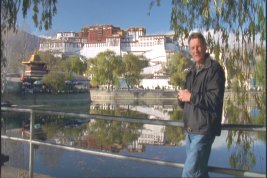 Since his 'retirement' from performing as part of the greatest sketch comedy company in the history of television, Michael Palin has made it his goal to open up the planet, its places and its people, to viewers who otherwise would never get the chance to experience their riches. Whether it's trying to recreate a famous literary voyage or unlocking the secrets of one of the planet's most hostile regions, Palin plays both guide and go-between, our introduction into a strange new setting and an intermediary for our understanding of its rich wealth of culture diversity and significance. With his latest sojourn, Palin takes on the Himalayas, and over the course of six sensational hours, we get to experience the majesty, and the menace, of this magical mountain range.
Since his 'retirement' from performing as part of the greatest sketch comedy company in the history of television, Michael Palin has made it his goal to open up the planet, its places and its people, to viewers who otherwise would never get the chance to experience their riches. Whether it's trying to recreate a famous literary voyage or unlocking the secrets of one of the planet's most hostile regions, Palin plays both guide and go-between, our introduction into a strange new setting and an intermediary for our understanding of its rich wealth of culture diversity and significance. With his latest sojourn, Palin takes on the Himalayas, and over the course of six sensational hours, we get to experience the majesty, and the menace, of this magical mountain range.
The DVD:
As he has done five times previously, Monty Python alumni Michael Palin is off to see the world. But instead of trying to break the fictional record of one Phileas Fogg (Around the World in 80 Days, 1989), travel from the top of the planet to the very bottom (Pole to Pole, 1992), circumnavigate the entire Pacific rim (Full Circle, 1997), retrace the footsteps of a great writer (Hemingway Adventure, 1999) or explore the world's largest desert (Sahara, 2002), Palin intends to tackle what is perhaps the fiercest mountain range on Earth. Himalaya will see the actor turned adventurer follow the chain of peaks from their starting point (the Khyber Pass in Pakistan) through India, Nepal, Tibet, China, and Bhutan, finally ending up in the Bay of Bengal in Bangladesh. Along the way, he will visit the Dalai Lama, camp at the foot of Everest, and meet the various ethic traditions that pepper this rich, diverse landscape.
The six hour long episodes included on this DVD set take us through Palin's complete voyage. Most of it was made on foot, since there are few actual roads in the region. For a small taste of the travel treasures he unveils, here is a very minor breakdown (as not to spoil the delight of discovery) of each installment:
North By Northwest: At the very start of his journey, Palin plays cricket with some local children, visits the last of Pakistan's disappearing royalty, and sees a polo match played near the top of the world.
A Passage To India: From the Golden Temple at Amritsar to a visit with the Dalai Lama, Palin gets to travel on the Himalayan Queen railroad and visit an old fashioned British music hall high in the mountains, the Gaiety Theater.
Annapurna To Everest: As Palin attempts to get acclimatized to the dizzying heights, he makes a stopover in Katmandu, feels the fragility of his age, and has his first doubts that he will be able to complete the entire trip.
The Roof of the World: Showing the rich diversity, both economically and culturally, of the region, Palin travels from a booming capitalist city to a remote rural horse fair, as well as to the most bucolic setting of the entire trek.
Leaping Tigers, Naked Nagal: After visiting with a local pop star to learn the sexual customs of her people (not literally), Palin runs across some headhunters, visits a tea plantation and spends some time in the Kaziranga National Park.
Bhutan to the Bay of Bengal: As the journey winds down, Palin participates in a rare religious ceremony, experiences the beauty that is the Popshika Valley, and explores the mysterious nation of Bangladesh.
Make no mistake about it - Michael Palin's Himalaya is astonishing. It's as majestic as the mountains he is hiking through and as rich in culture and history as the countries he comes in contact with. Of Palin's previous travelogues, this six part outing is the most dogmatically bifurcated. On one hand, there are the city dwellers, caught up in politics, theology and commerce. But once our genial guide gets up into the hills, all pretense of cosmopolitanism disappears. Along the peaks and valleys, tribalism and tradition rules, and Palin passes through each and every aspect with curiosity and courtesy. Himalaya is not an attempt to confront East Asian ideals. Islam is no more incendiary than Buddhism or Hindi in this all-inclusive adventure. Tensions are mentioned, but we never see the signs of strife that litter the scenery like the fertile grasslands in the numerous valleys.
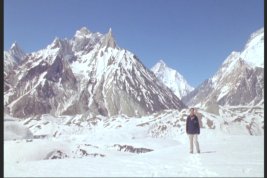 Palin is, perhaps, the perfect host for a showcase like this. His insights are learned, and yet he's willing to drop pretense and experience his escapade through the eyes of his audience. When he questions anyone - be they locals or leaders - he offers a respectable skepticism, a slightly Colonial curiosity that lets the nation or its people prove itself to the rest of the world. This makes his interactions more realistic. We become almost saturated with Palin's desire to drink in everything around him - information AND location. As a result, there is a kind of out of body experience that goes along with watching this series. Though we are seated comfortably in our living room, watching Palin's pained face as he tries to adjust to the ever-increasing altitude, we suddenly and unexpectedly start to sympathize. As he suffers, so do we. As he rejoices, so do we. It's the rarest of realities for an entertainment series - that ability to get you tuned in and synchronized with the show. Himalaya does this over and over again.
Palin is, perhaps, the perfect host for a showcase like this. His insights are learned, and yet he's willing to drop pretense and experience his escapade through the eyes of his audience. When he questions anyone - be they locals or leaders - he offers a respectable skepticism, a slightly Colonial curiosity that lets the nation or its people prove itself to the rest of the world. This makes his interactions more realistic. We become almost saturated with Palin's desire to drink in everything around him - information AND location. As a result, there is a kind of out of body experience that goes along with watching this series. Though we are seated comfortably in our living room, watching Palin's pained face as he tries to adjust to the ever-increasing altitude, we suddenly and unexpectedly start to sympathize. As he suffers, so do we. As he rejoices, so do we. It's the rarest of realities for an entertainment series - that ability to get you tuned in and synchronized with the show. Himalaya does this over and over again.
The reason why showcases like Himalaya are so spectacular is that they don't merely focus on the travel. Instead, Palin proves that there is life behind the tourist attractions, real people populating the food stands and souvenir kiosks. As a host, he is inquisitive and unafraid to ask the dorky or dumb question. If the answer can bring a certain amount of clarity to a country, or help us better understanding of a custom or calling, that's all he really cares about. As a result, we get conversations along with our color scenic snapshots, ritual and tradition tossed inside a canvas of devastating beauty. It's these moments that really mark Himalaya, a chance to see the indigenous people doing what they've done for thousands of years. A polo match between rival villages is played on a plain high in the hills, surrounded on all sides by summits of sumptuous beauty. Simple villagers enjoy festivals in celebration of the horse or elephant, and aren't shy about explaining their significance. As the visuals verify the vastness of this often perplexing planet, the interactions between Palin and the populace bring the 'small world' dynamic to life.
As he's aged (he was 61 when the series premiered) Palin has become more passive in his travels. During episodes of Pole to Pole or Around the World in 80 Days, you'd often see the star acting up, putting on the Python for the locals who almost notoriously recognize him. But with Monty's memory fading (if ever slightly) combined with the relative isolation of the area he's visiting (some countries and towns he's visiting had no communication with the outside world up until a decade ago), Palin is finally free to travel without his fellow funnymen tagging along - metaphorically speaking. Though he makes occasional references to the mad Monty days, this is one of the rare instances where the actor isn't trading on such familiarity to sell his story. Instead, he truly loses himself in his travels, no longer standing out as a star of a classic comedy show. Instead, he has become the intrepid explorer and able authority that years in service of such a platform can create.
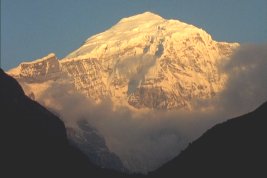 That being said, this is a stunning visual feast, the truest definition of eye candy there is. If one were incapable of hearing the narrative and conversations, one would still be able to enjoy the exquisite locales and landscapes. Using a scope both epic and intimate to make its points, Himalaya never once disappoints our sense of awe. When Palin promises a stunning view, we get one of the most amazing ever. Casual moments in hillside cafes register remarkable panoramas. Heck, even a 'special' toilet (nothing more than a trough cut out of the bottom of a hut) offers one of the most marvelous mountain outlooks of the entire journey. As Palin says frequently, we can truly understand the lure of the Himalayas (or any range, for that matter) when experiencing it this way. Being able to sleep in its valleys, interact with its streams and rivers, to become literally one with its environmental temperaments is part of the programs charms. Thanks to the visual opulence in both backdrop and humanity, this is one optical banquet that we walk away from very full and very satisfied.
That being said, this is a stunning visual feast, the truest definition of eye candy there is. If one were incapable of hearing the narrative and conversations, one would still be able to enjoy the exquisite locales and landscapes. Using a scope both epic and intimate to make its points, Himalaya never once disappoints our sense of awe. When Palin promises a stunning view, we get one of the most amazing ever. Casual moments in hillside cafes register remarkable panoramas. Heck, even a 'special' toilet (nothing more than a trough cut out of the bottom of a hut) offers one of the most marvelous mountain outlooks of the entire journey. As Palin says frequently, we can truly understand the lure of the Himalayas (or any range, for that matter) when experiencing it this way. Being able to sleep in its valleys, interact with its streams and rivers, to become literally one with its environmental temperaments is part of the programs charms. Thanks to the visual opulence in both backdrop and humanity, this is one optical banquet that we walk away from very full and very satisfied.
Naturally, one needs to thank the men behind the cameras for their tireless work in making such a series a reality. One of the unsung heroes of Himalaya is director Roger Mills, a constant companion to Palin on all his travels (except for the Hemingway Adventure through Africa). Along with help from co-director John-Paul Davidson (whose been on board since Sahara in 2002) we have craftsman who perfectly understand both pace and the picturesque. With so much material to digest and present, so many stunning vistas to drink in and extol, it would be easy for a program like this to become a jumbled, incoherent mess. But thanks to the efforts of these amazing documentarians, we get a sense of the surroundings as well as the situations our star finds himself in. Something as complex as the Buddhist belief system, the history of Pakistani royalty, or the intricate theocracies crafted out of Islam can barely be summed up in a single series, let alone a couple of sequences. But somehow, in combination with Palin's insightful writing (he pens all the narratives here) these filmmakers find the symbols, the icons, and the elements that encapsulate the ideas perfectly.
Indeed, that's the best way to describe Himalaya. Palin and pals are able to take a region dense with diversity and more or less completely foreign to the Western mindset (whatever you originally thought about Eastern Asia will be immediately erased by this program) and flawlessly translate it into a televisual experience unlike any in the modern media. Ideas that seem downright primitive (lack of gender equality, theocracies) make sense here, because they are buffered by, and contextualized through, the mountain-studded milieu. We don't see the agenda-based face offered by news agencies and other documentarians. Though filmed after 9/11 and the US War in Afghanistan, there are few reminders of such savagery. Aside from a hillside adorned with the seals of several British regiments who fought in the area, you would never know that the mountain chain Palin is plodding through exists as part of the so-called "axis of evil".
Himalaya proves that some sovereignty remains nationalistic, not global. It celebrates diplomacy and detente, while proving that most resistance efforts seem futile in light of the natural splendor surrounding them (a Maoist uprising which strikes a little too close to home for Palin and his patrons is a perfect example of this). With traditions that go back thousands of years, areas that appear locked in such ancient attitudes, and the slowly creeping influence of modern technology into the mix, we literally see evolution and civilization forming before our eyes. At a dinner in Bhutan, Palin discusses the myth of Shangri-La, and how many people point to this small nation as the living example of the legend. The people in attendance scoff, but for those of us on the outside, such sentiments are spot on. Himalaya lets us into a part of this planet that does seem mystic, carved out of karma and confidence. Thanks to this and other remarkable expeditions by Palin, we get the rare chance to witness their grandeur firsthand. This is a spectacular series, one of the best in the ex-Python's portfolio. It should not be missed.
The Video:
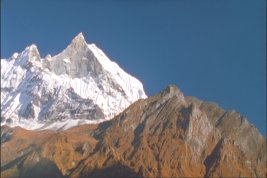 In a word - dazzling. Frankly, how could it not be? Made within the last few years, when filmic formats allow for incredible detail and dimension, the images from Himalaya's 1.85:1 anamorphic widescreen transfer literally leap off the screen. You feel the cold, experience the exhaustion, weather the hardships and experience the splendor first hand, thanks to the flawless visual presentation. This region of the world is known for its colorful, almost psychedelic ideals when it comes to everyday life and we get every Technicolor treat in full blown beauty. All TV shows should hope to look so lovely.
In a word - dazzling. Frankly, how could it not be? Made within the last few years, when filmic formats allow for incredible detail and dimension, the images from Himalaya's 1.85:1 anamorphic widescreen transfer literally leap off the screen. You feel the cold, experience the exhaustion, weather the hardships and experience the splendor first hand, thanks to the flawless visual presentation. This region of the world is known for its colorful, almost psychedelic ideals when it comes to everyday life and we get every Technicolor treat in full blown beauty. All TV shows should hope to look so lovely.
The Audio:
The sound provided for Himalaya - in both a natural and musical scoring mode - is equally breathtaking. The amazing ambient backing tracks composed and collected for the series manage to mimic and magnify the lush and verdant variable of the landscape completely. The mixture of cultural cues presented by the Dolby Digital Stereo setting is also exceptional (an old poet sings a song that will break your heart). Equally important, the conversations and narration are always clean, crisp and easily understood. Even in the harshest domain, Palin's descriptions and comments are clear as a bell.
The Extras:
After sitting through six hours of this remarkable journey, the first thoughts that come to mind are MORE...MORE...MORE!!! And that is exactly what the DVD version of Himalaya gives you. Each episode has additional footage as part of the special features, and this material is just as spellbinding as the series itself. Sometimes, Palin provides a kind of homemade narrative track (since no post-production was done on a few of the sequences). In other instances, we get vignettes that could have very easily been inserted into the show. Totaling over two hours, it's like getting two extra episodes of the series. In addition, Palin offers a 10 minute introduction to the show, and a 30 minute interview/wrap-up at the end. This material allows us some additional insights into the reason he made the trip, as well as getting a chance to hear Palin reminiscence over some of the more meaningful moments during the journey. Aside from the lack of a map (which, frankly, should have been mandatory) the added content here is fantastic.
Final Thoughts:
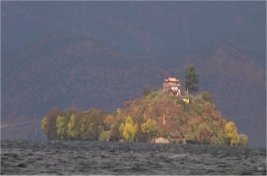 Many of us never get the opportunity to travel. No, not to a neighboring state, or some tacky tourist destination. The world lays before us like one giant book just waiting to be read, and yet so few of us ever get the opportunity to leaf past the first few pages. Thanks to people like Michael Palin - an individual willing to shuffle about the continents in search of the story of ourselves - we at least get an incomplete, Cliff's Notes version of the globe. Himalaya is why the documentary format is so fascinating - it takes the truth and makes it far more dramatic, daring and desirable than fiction can ever formulate. This is one of the best DVD packages of the year, a worthy addition to the canon of caravanning that Palin has pursued over the last two decades. Yet unlike those previous passages, this one seems different. In the past, Palin has skimmed through the countries and skimped on the particulars, as time and trip logistics dictated. Himalaya feels fuller than that, more complex and complete. We get a true vision of a realm, both in perspective and panorama. It may indeed be a big world, but thanks to Michael Palin, the BBC and Himalaya, it's becoming a little less intimidating and far more intimate - just the way it should be.
Many of us never get the opportunity to travel. No, not to a neighboring state, or some tacky tourist destination. The world lays before us like one giant book just waiting to be read, and yet so few of us ever get the opportunity to leaf past the first few pages. Thanks to people like Michael Palin - an individual willing to shuffle about the continents in search of the story of ourselves - we at least get an incomplete, Cliff's Notes version of the globe. Himalaya is why the documentary format is so fascinating - it takes the truth and makes it far more dramatic, daring and desirable than fiction can ever formulate. This is one of the best DVD packages of the year, a worthy addition to the canon of caravanning that Palin has pursued over the last two decades. Yet unlike those previous passages, this one seems different. In the past, Palin has skimmed through the countries and skimped on the particulars, as time and trip logistics dictated. Himalaya feels fuller than that, more complex and complete. We get a true vision of a realm, both in perspective and panorama. It may indeed be a big world, but thanks to Michael Palin, the BBC and Himalaya, it's becoming a little less intimidating and far more intimate - just the way it should be.
Want more Gibron Goodness? Come to Bill's TINSEL TORN REBORN Blog (Updated Frequently) and Enjoy! Click Here
|
| Popular Reviews |
| Sponsored Links |
|
|
| Sponsored Links |
|
|
| Release List | Reviews | Shop | Newsletter | Forum | DVD Giveaways | Blu-Ray | Advertise |
|
Copyright 2024 DVDTalk.com All Rights Reserved. Legal Info, Privacy Policy, Terms of Use,
Manage Preferences,
Your Privacy Choices | |||||||












